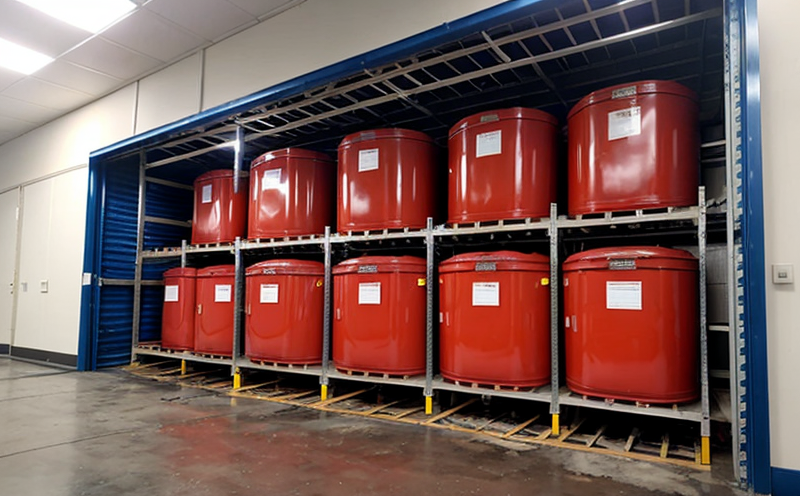High rack storage fire safety inspection
The high rack storage fire safety inspection is an essential component of comprehensive fire protection strategies in industrial facilities. This service ensures that the design and implementation of high-rack storage systems meet stringent international standards, enhancing both compliance and operational efficiency. The process involves detailed inspections to identify potential hazards and recommend corrective measures that align with best practices.
High rack storage systems are prevalent in warehouses and manufacturing plants where vertical space is optimized for maximum capacity. These structures present unique challenges when it comes to fire safety due to the height, density of stored materials, and the potential for rapid fire spread. Therefore, a thorough inspection process is crucial to mitigate risks effectively.
The inspection typically begins with an assessment of the storage system's design parameters against relevant international standards such as ISO 9774-1:2006, which specifies the terminology and basic principles applicable to fire safety engineering. Compliance with these guidelines ensures that the facility meets global expectations for fire safety in high-rack environments.
During the inspection, key areas are evaluated including structural integrity, ventilation systems, fire detection and suppression systems, and access routes. The aim is to ensure all components function correctly under normal operating conditions as well as during emergencies. Structural assessments often involve visual inspections combined with non-destructive testing techniques like ultrasonic scanning or radiography where necessary.
One of the most critical aspects of high rack storage fire safety inspection lies in evaluating the ventilation system's performance. Proper airflow management is vital for preventing hot smoke from accumulating near ceiling levels, which could otherwise hinder firefighting efforts or cause rapid flashover incidents. Ventilation systems must be designed to allow fresh air to circulate throughout the facility while minimizing the spread of flames.
Fire detection and suppression systems also play a crucial role in safeguarding high rack storage facilities. These systems should include early warning mechanisms such as heat detectors, smoke detectors, or combination devices that respond to both conditions simultaneously. The suppression component might comprise sprinkler systems, gas extinguishing systems, or dry-pipe systems depending on the specific requirements of the facility.
Access routes are another critical element under scrutiny during high rack storage fire safety inspections. These include stairs, ladders, catwalks, and any other pathways used by personnel to reach elevated areas within the warehouse. Ensuring these routes remain clear at all times is essential for emergency evacuations as well as routine maintenance activities.
The inspection process extends beyond mere compliance with regulations; it emphasizes continuous improvement through ongoing monitoring and adjustments based on changing conditions or technological advancements. By identifying vulnerabilities early, facilities can implement proactive measures to enhance their overall fire safety posture.
- ISO 9774-1:2006 – Terminology and basic principles applicable to fire safety engineering
- American Society for Testing Materials (ASTM)
- European Standard EN 13571:2008 – Fire safety requirements for high-rack storage facilities
- International Electrotechnical Commission (IEC) standards
Why It Matters
The importance of a robust fire safety inspection in high rack storage cannot be overstated. These inspections serve multiple purposes, each contributing significantly to the overall safety and reliability of industrial facilities:
- Compliance with Regulations: Ensures adherence to local, national, and international regulations regarding fire safety.
- Risk Management: Identifies potential risks early on so they can be addressed before they lead to accidents or incidents.
- Enhanced Reputation: Demonstrates commitment to excellence in operational practices which is crucial for maintaining customer trust and satisfaction.
- Cost Savings: Prevents costly downtime caused by unforeseen issues that could arise if problems were left unaddressed.
In today’s competitive environment, businesses need more than just compliance; they require assurance that their facilities are safe, efficient, and capable of withstanding emergencies. A well-executed fire safety inspection provides this level of confidence, giving organizations peace of mind knowing they have taken all necessary precautions to protect lives and assets.
International Acceptance and Recognition
- American Society for Testing Materials (ASTM): ASTM E1357-09 covers the design, installation, operation, and maintenance of high-hazard storage facilities. This standard addresses various aspects including structural integrity, fire detection systems, and emergency procedures.
- European Standard EN 13571:2008: This European Norm sets out specific requirements for fire safety in high-rack storage structures, covering everything from construction materials to operational practices. Compliance with this standard ensures facilities meet EU-wide standards.
- International Electrotechnical Commission (IEC): IEC publications provide guidance on electrical installations within buildings and industrial premises, which is particularly relevant for high rack storage due to its reliance on power systems for operations like lighting, ventilation, and firefighting equipment.
The acceptance of these standards varies across different regions but generally reflects a global consensus on best practices in fire safety. Organizations that comply with internationally recognized standards gain credibility both domestically and abroad, making them attractive partners for international collaborations or expansions into new markets.
Competitive Advantage and Market Impact
Incorporating comprehensive high rack storage fire safety inspection services into one’s offerings can provide several competitive advantages. Firstly, it demonstrates a commitment to excellence that resonates well with clients who prioritize safety above all else. Secondly, by ensuring compliance with stringent international standards, businesses position themselves as industry leaders capable of delivering top-notch performance in challenging environments.
Moreover, implementing these services helps organizations stay ahead of regulatory changes and evolving best practices. As fire protection technology continues to advance, staying informed about the latest developments ensures facilities remain up-to-date without needing costly overhauls later down the line.
The market impact extends beyond individual clients; it contributes positively towards broader societal goals by promoting safer working conditions across industries. By reducing incidents related to fires in high rack storage facilities, businesses contribute to improved public safety and reduced environmental impacts resulting from potential accidents.





